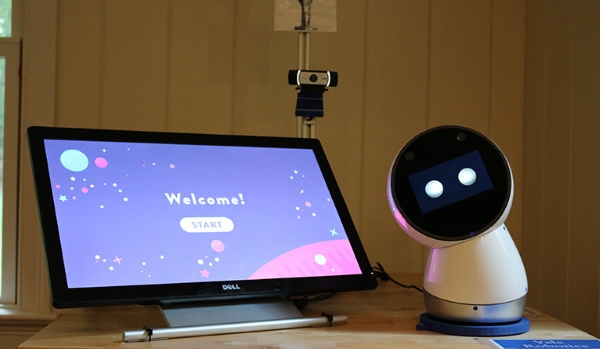[A new study demonstrates the potential of medium-as-social-actor presence to help develop the social skills of children with autism (and possibly others). The story is from Yale News, where it includes a 2:14 minute video. –Matthew]

Robots help children with autism improve social skills
By William Weir
August 22, 2018
A study led by Yale researchers found significant improvements in the social skills of children with Autism Spectrum Disorder (ASD) after a month of working with robots.
Modeling eye contact and other social behaviors, the robots guided the children of 12 participating families through storytelling and interactive games designed to promote social skills such as emotional understanding, taking turns, and seeing things from others’ perspectives. The results are published Aug. 22 in Science Robotics.
The study, led by Brian Scassellati, professor of computer science, began with a baseline assessment of the children’s skills and emotional development. One month later, a robot was placed in each of the homes, and the children worked with the robots for 30 minutes every day for 30 days. For the last part of the study, researchers assessed the children again one month later to measure their progress.
The improvements in social behaviors were seen in the clinical data, including the scores of the six interactive games, said the researchers. The children’s caregivers (in this study, either a parent or a grandparent) also reported that the children were noticeably better at making eye contact and initiating communication by the end of the study.
“The children showed improved performance across the board,” Scassellati said. “This was more than we had hoped; not only did the children and parents still enjoy working with the robot after a month, but the children were showing improvements that persisted even when the robots were not around.”
Known as social robots, the machines used for the study are designed specifically to interact with humans. The sophisticated program that controls the robots allows the robots to adapt to an individual child’s ways of learning. Depending on how well the children did, the robots’ games could change substantially.
Making the sessions both fun and challenging for the child was critical to the study, say the scientists. Previous research has shown that short sessions with robots can have significant short-term learning results for children with autism. By the third or fourth day, though, children will often lose interest. The robots in this study did significantly better in maintaining interest. Their caregivers reported that the children were happy to work with the robot throughout the 30 days. The study also demonstrated that the robots could work effectively outside the laboratory setting, adapting to the unique environments of each home, said the researchers.
Scassellati has spent years studying human-robot interactions. One consistent finding, he notes, has been that children with ASD respond particularly well to robots. Many of these children are intimidated by common social situations, he said, and they feel safer interacting with the robots.
“These are kids who have years of experience with the idea that social interaction is challenging and something they don’t understand,” he said. “When they interact with the robot, though, it triggers social responses but it doesn’t trigger a lot of the other baggage they’ve come to associate with social interaction.”
The study represents a significant advance in the lab’s work with social robots, said Scassellati, adding that future studies will aim to give the robots an even more prominent role.
“We have been working toward this result for almost 15 years, but always in the past with robots that operated for only short periods and only under very controlled laboratory conditions,” he said. “This is the first study that put fully autonomous robots directly into homes, but we will need these robots to operate for more than a month in order to support social skill learning more broadly.”
Five universities participated in the study, with 15 faculty members spanning numerous disciplines, including computer science, mechanical engineering, education, medicine, and nutrition.
The research was supported by the U.S. National Science Foundation under the Expeditions in Computing program.